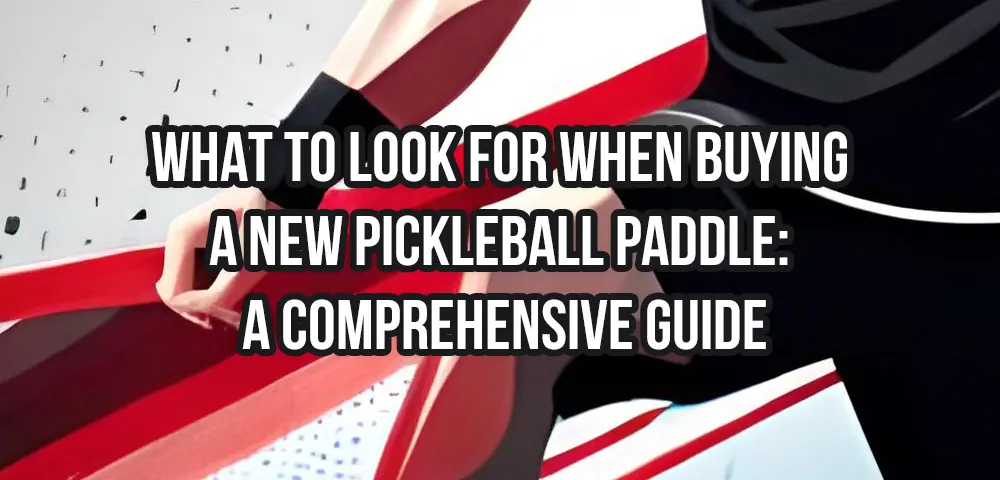What to Look for When Buying a New Pickleball Paddle: A Comprehensive Guide
A pickleball paddle is a crucial piece of equipment that can greatly impact your performance and enjoyment on the court. With numerous options available, choosing the right pickleball paddle can seem overwhelming. In this comprehensive guide, we’ll walk you through the key factors to consider when buying a new pickleball paddle. Drawing insights from the Pickleball Review Hub, we’ll cover paddle materials, weight and balance, grip size, paddle shape, and surface texture. Armed with this knowledge, you’ll be empowered to make an informed decision that suits your playing style and enhances your overall pickleball experience.
Paddle Materials: Composite, Graphite, or Wood
Pickleball paddles are typically made from three primary materials: composite, graphite, and wood. Pickleball Review Hub highlights the characteristics of each material. Composite paddles, made from a blend of materials like fiberglass and polymer, offer a good balance of power, control, and durability. Graphite paddles are known for their lightweight nature and enhanced maneuverability. They provide excellent touch and control, making them popular among players seeking finesse. Wood paddles, on the other hand, offer a traditional feel and are often favored by recreational players. They provide a softer touch and are generally more affordable. Consider your playing style, preferences, and budget when deciding on the paddle material that best suits you.
Weight and Balance: Finding the Right Combination
The weight and balance of a pickleball paddle are crucial considerations that can greatly influence your performance. Pickleball Review Hub advises considering both the overall weight and the distribution of weight. Lighter paddles (usually ranging from 6 to 8 ounces) offer maneuverability and control, while heavier paddles (8 to 14 ounces) provide more power and stability. Additionally, the balance of a paddle refers to how weight is distributed throughout the paddle. There are three main balance types: head-heavy, even balance, and handle-heavy. Head-heavy paddles provide more power, while handle-heavy paddles offer greater control. Even balance paddles strike a balance between power and control. Experimenting with different weights and balance points can help you find the right combination that suits your playing style and preferences.
Grip Size: Comfort and Control
The grip size of a pickleball paddle plays a significant role in your comfort and control on the court. Pickleball Review Hub recommends choosing a grip size that allows you to maintain a relaxed grip while still maintaining control over the paddle. Grip sizes typically range from 4 inches to 4 ½ inches in circumference. Players with smaller hands may prefer a smaller grip size, while those with larger hands may opt for a larger grip size. It’s essential to find a grip size that feels comfortable and natural in your hand, as it can prevent fatigue and enhance your ability to maneuver the paddle effectively.
Paddle Shape: Traditional vs. Widebody
Pickleball paddles come in two main shapes: traditional and widebody. Traditional-shaped paddles have a narrower design, allowing for quick and precise shots. They provide better maneuverability and control, making them popular among experienced players. Widebody paddles, as the name suggests, have a wider face. They offer a larger sweet spot, which can be beneficial for beginners or players who prioritize power and forgiveness. Pickleball Review Hub suggests trying both paddle shapes to determine which one feels more comfortable and suits your playing style. It’s important to note that while shape is a personal preference, it can have an impact on your shot-making ability and overall performance.
Surface Texture: Smooth vs. Textured
The surface texture of a pickleball paddle can affect the spin, control, and feel of the ball. Smooth-faced paddles offer less grip on the ball, resulting in less spin potential but providing a predictable and consistent feel. Textured or rough-faced paddles, on the other hand, offer more grip on the ball, allowing for increased spin and control. Pickleball Review Hub suggests considering your playing style and preferences when choosing the surface texture. If you rely on spin shots and want enhanced ball control, a textured paddle may be a suitable choice. However, if you prioritize a consistent and predictable feel, a smooth-faced paddle might be the better option.
Choosing the right pickleball paddle is a personal and important decision for every player. By considering factors such as paddle materials, weight and balance, grip size, paddle shape, and surface texture, you can make an informed choice that aligns with your playing style and preferences. The insights from the Pickleball Review Hub provide valuable guidance to help you navigate the vast array of options available. Remember to try different paddles, if possible, and seek recommendations from experienced players or coaches. Ultimately, finding the perfect pickleball paddle will enhance your performance, enjoyment, and overall experience on the court.


Leave a Reply